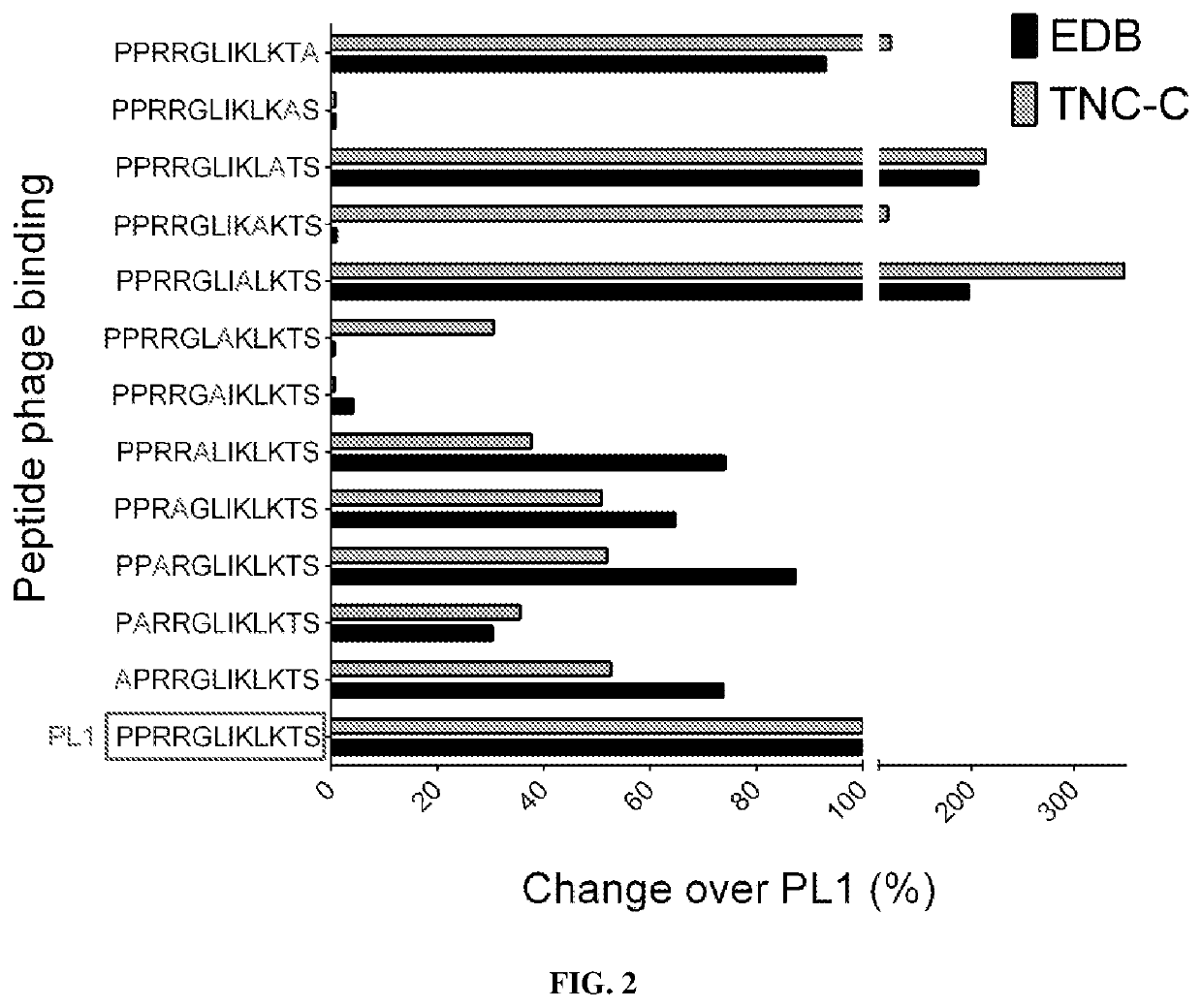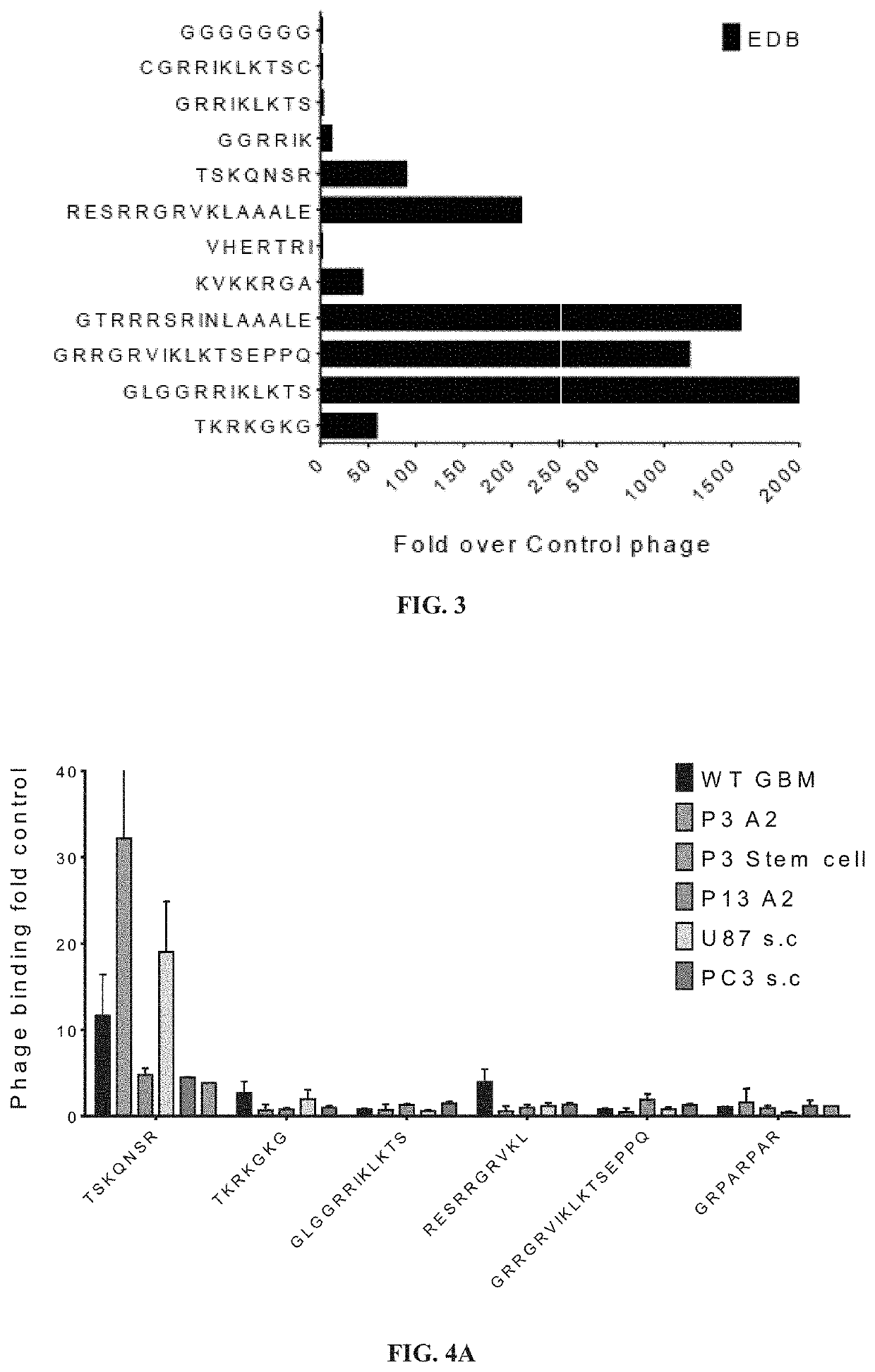Bi-specific extracellular matrix binding peptides and methods of use thereof
a technology of extracellular matrix and binding peptide, which is applied in the field of molecular medicine and cancer treatment, can solve the problems of poor tissue penetration, high production cost of antibodies, and difficult targeting of fn-edb and tnc-c, and achieve the effect of increasing apoptosis
- Summary
- Abstract
- Description
- Claims
- Application Information
AI Technical Summary
Benefits of technology
Problems solved by technology
Method used
Image
Examples
example 1
and Properties of PL1 Peptide and Related Peptides
A. Materials and Methods
[0541]1. Materials
[0542]Phosphate-buffered saline (PBS) was purchased from Lonza (Verviers, Belgium), K3[Fe (CN)6], HCl, Nuclear Fast Red, Xylene substitute, isopropanol, Triton-X, Tween-20, CHCl3, MeOH, and dimethylformamide (DMF) were purchased from Sigma-Aldrich (Munich, Germany). Cloning, expression, purification of proteins (FN-EDB, TNC-C, NRP1, NCL and single chain antibodies FN-EDB-L19 and TNC-C-G11), and generation of polyclonal rabbit antibodies are described below and in Table 1.
TABLE 1List of antibodies usedAntibodyVendorCatalogue numberDilutionanti-His-tagAbcam, Icosagenab5000, 1:5000A2-501-100anti-fluoresceinThermo FisherA8891:200ScientificCD31BD Biosciences557355, 5533701:200nestinThermo FisherMA1-1101:100ScientificCD11bBD Biosciences5573951:100LYVE-1eBioscience140443821:200CD68Bio-RadMCA1957A4881:100Ki67NovusbioNB500-170cleavedCell Signaling9661:200caspase-3TechnologyFN-EDBAbsoluteantibodyAb0063...
example 2
and Properties of PL2 Peptide and Related Peptides
[0616]Peptides were selected and tested for binding to FN-EDB generally using techniques and protocols as described in Example 1. The data and results are shown in FIGS. 3-5 and 22.
A. Materials and Methods
[0617]1. Materials
[0618]Phosphate-buffered saline (PBS) was purchased from Lonza (Verviers, Belgium). K3[Fe(CN)6], HCl, isopropanol, Triton-X, Tween-20, CHCl3, MeOH, Isopropyl β-D-1-thiogalactopyranoside (IPTG) and dimethylformamide (DMF) were purchased from Sigma-Aldrich (Munich, Germany).
[0619]2. Peptides and Proteins
[0620]Cys-5(6)-carboxyfluorescein (FAM)-PL2 and Cys-FAM peptides with 6-aminohexanoic acid spacer were purchased from TAG Copenhagen (Denmark). The pASK75-Fn7B8 and pASK75-Fn789 plasmids kindly provided by Prof. Dr. Arne Skerra (Schiefner et al., 2012). Gene fragments for Fn-EDB domains were amplified from the plasmids and cloned into pET28a+ plasmid containing His6-tag at N-terminal for expression in E. coli BL21 Ros...
example 3
and Properties of PL3 Peptide and Related Peptides
[0654]Peptides were selected and tested for binding to TNC-C generally using techniques and protocols as described in Example 1. Some of the data and results are shown in FIGS. 6-8.
A. Materials and Methods
[0655]1. Materials
[0656]Phosphate-buffered saline (PBS) was purchased from Lonza (Verviers, Belgium). K3[Fe(CN)6], HCl, isopropanol, Triton-X, Tween-20, CHCl3, MeOH, Isopropyl β-D-1-thiogalactopyranoside (IPTG) and dimethylformamide (DMF) were purchased from Sigma-Aldrich (Munich, Germany). Cys-fluorescein (FAM)-PL3 and Cys-FAM peptides with 6-aminohexanoic acid spacer were purchased from TAG Copenhagen (Denmark). [D(KLAKLAK)2] and [D(KLAKLAK)2]-PL3 peptides (SEQ ID NO:6) were synthesized using Fmoc / t-Bu chemistry on a microwave-assisted automated peptide synthesizer (Liberty; CEM Corporation, Matthews, N.C., USA). Peptides were purified by high-performance liquid chromatography (HPLC) using 0.1% trifluoroacetic acid (TFA) in aceton...
PUM
| Property | Measurement | Unit |
|---|---|---|
| Fraction | aaaaa | aaaaa |
| Fraction | aaaaa | aaaaa |
| Fraction | aaaaa | aaaaa |
Abstract
Description
Claims
Application Information
 Login to View More
Login to View More - R&D
- Intellectual Property
- Life Sciences
- Materials
- Tech Scout
- Unparalleled Data Quality
- Higher Quality Content
- 60% Fewer Hallucinations
Browse by: Latest US Patents, China's latest patents, Technical Efficacy Thesaurus, Application Domain, Technology Topic, Popular Technical Reports.
© 2025 PatSnap. All rights reserved.Legal|Privacy policy|Modern Slavery Act Transparency Statement|Sitemap|About US| Contact US: help@patsnap.com



